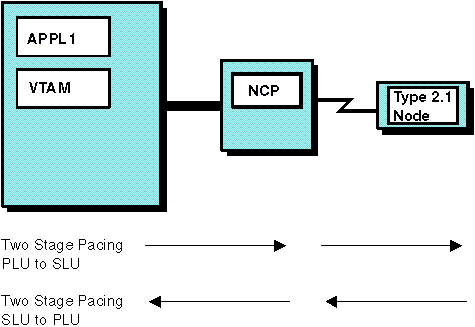 z/OS Communications Server: SNA Network Implementation Guide
z/OS Communications Server: SNA Network Implementation Guide
 z/OS Communications Server: SNA Network Implementation Guide
z/OS Communications Server: SNA Network Implementation Guide
|
Previous topic |
Next topic |
Contents |
Contact z/OS |
Library |
PDF
Adaptive session-level pacing z/OS Communications Server: SNA Network Implementation Guide SC27-3672-01 |
|
|
Adaptive session pacing allows the pacing window size to dynamically:
Adaptive pacing occurs between each pacing stage endpoint and can vary for each direction. In Figure 1, APPL1 is in session with a type 2.1 node. Two-stage pacing occurs for data flowing in both directions between the session partners. Figure 1. Adaptive session pacing
 If adaptive pacing is performed, the value determined during session setup for the pacing window size represents the minimum pacing window size to be used during normal operation. Note: Before VTAM® Version 4
Release 4, VTAM did not dynamically
vary the session partner send window size. VTAM always returns the same window size that
was set during session establishment. However, VTAM honors the pacing windows sent by its pacing
stage partners for adaptively paced sessions. The next window size
used for data transmission is whatever value was received from the
session partner in the pacing response.
An isolated pacing message (IPM) indicates whether the pacing window size should be changed. Pacing window sizes are changed by IPMs. The IPM, like the IPR used in fixed session pacing, is used to authorize the sending of the next window of messages units, but it also specifies whether the window size is to be changed or remain the same. The following scenario describes how adaptive pacing works.
Note: You must have NCP Version 5 Release 2, or higher, to support
two-stage and adaptive-session pacing involving a 3745 communication
controller, or Version 4 Release 3, or higher, for a 3725 communication
controller.



|
 Copyright IBM Corporation 1990, 2014 Copyright IBM Corporation 1990, 2014 |